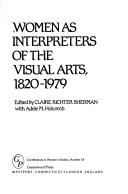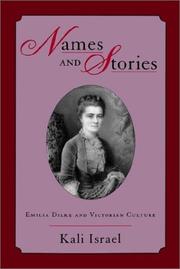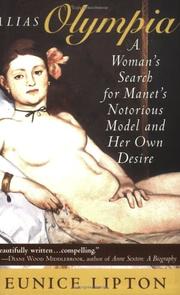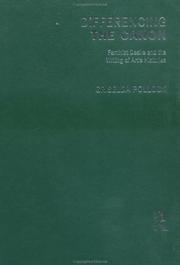| Listing 1 - 10 of 14 | << page >> |
Sort by
|
Book
ISBN: 8420480797 Year: 1996 Publisher: Madrid Alfaguara
Abstract | Keywords | Export | Availability | Bookmark
 Loading...
Loading...Choose an application
- Reference Manager
- EndNote
- RefWorks (Direct export to RefWorks)
#BIBC:ruil
Book
ISBN: 305005980X 9783050059808 3110379945 Year: 2014 Publisher: Berlin ; Boston : De Gruyter (A),
Abstract | Keywords | Export | Availability | Bookmark
 Loading...
Loading...Choose an application
- Reference Manager
- EndNote
- RefWorks (Direct export to RefWorks)
Beinahe zeitgleich mit der im November 1913 eröffneten Ausstellung der Funde von Tell el-Amarna im Berliner Ägyptischen Museum erschien Die Plastik der Aegypter von Hedwig Fechheimer (1871-1942). Die Ausstellung eröffnete Interessierten einen neuen Zugang zur ägyptischen Kunst in einer Zeit, die von kunsttheoretischen Debatten und den Auseinandersetzungen um Neo-Impressionismus, Kubismus und Expressionismus geprägt waren. Anders als Ägyptologen vom Fach, die damals fast durchgängig die archäologischen Überreste unter historischen und nicht unter ästhetischen Gesichtspunkten beurteilten, deutet Hedwig Fechheimer die Bestrebungen der ägyptischen Künstler als denen ihrer modernen Kollegen eng verwandt. Sie leugnete damit das seit Winckelmann gültige Dogma, das die ägyptische Kunst zu einer Vorläuferin der griechischen, wie sie schreibt, "herabgewürdigt" hat. Ihre Überlegungen sind mit denen von Carl Einstein zum Kubismus und zur ägyptischen und außereuropäischen Kunst verwandt; die Nähe zeigt sich besonders bei Einsteins Negerplastik von 1915. Sylvia Peuckert kann nun nachweisen, dass Fechheimer und Einstein bereits seit 1905 befreundet waren, 1910 gemeinsam nach Ägypten reisten und somit beiden Büchern eine lange Phase des geistigen Austausches vorangehen konnte. Bislang fehlten eine Auseinandersetzung mit Fechheimers eigener Deutung der ägyptischen Kunst und die Biographie einer Frau, die sich in ihrer Jugend mit den Restriktionen des Frauenstudiums im Deutschen Reich konfrontiert sah und im Alter von 71 Jahren einer Deportation nur durch die Flucht in den Tod entziehen konnte.
Jewish women --- Women art historians --- Art historians --- Women historians --- Fechheimer, Hedwig. --- Carl Einstein. --- Egyptology. --- History of science.

ISBN: 9780313220562 0313220565 Year: 1981 Publisher: Westport, Conn. : Greenwood Press,
Abstract | Keywords | Export | Availability | Bookmark
 Loading...
Loading...Choose an application
- Reference Manager
- EndNote
- RefWorks (Direct export to RefWorks)
Women art critics. --- Women art historians. --- Women art teachers. --- Art criticism --- Art, Modern --- Art, Modern --- History. --- History. --- History.
Book
ISBN: 9789042941915 904294191X 9789042941922 Year: 2020 Publisher: Leuven Peeters
Abstract | Keywords | Export | Availability | Bookmark
 Loading...
Loading...Choose an application
- Reference Manager
- EndNote
- RefWorks (Direct export to RefWorks)
Sie stand anderen zur Seite und wußte sie zu inspirieren." It is clear that Ernst H. Gombrich saw Gertrud Bing (1892-1964) as the muse in the circle of scholars around Aby M. Warburg (1866-1929). Others have compared her to the figure of the nymph, which was essential to Warburg?s thought. Indeed, with Warburg?s fascination for the ninfa fiorentina, a picturing of ?the feminine? enters into the centre of his thinking. However, Warburg almost never voiced opinions about the role of gender in the structure of society. Nor does it seem that he actually admitted women to his intellectual universe. Gertrud Bing, it turns out, was the rare exception.00Who was Gertrud Bing and what was her personal contribution to Warburg?s scientific project? This essay intends to map the agency of Gertrud Bing, in a way that she herself would have probably preferred. According to her, the ideal biography ought to merge the personal with the intellectual, since, what one experiences as a human being will also find its way into the academic oeuvre one leaves behind.
Book
Abstract | Keywords | Export | Availability | Bookmark
 Loading...
Loading...Choose an application
- Reference Manager
- EndNote
- RefWorks (Direct export to RefWorks)
In her early diaries the art historian Erica Tietze-Conrat describes her eventful life in Vienna in the 1920's, were she had been in touch with all the important art circles of the time.. In 1937 and 1938 her journals give an interesting view of the networks between museums, art dealers, art scholars and artists just before the outbreak of World War II.
Art historians --- Women art historians --- Tietze-Conrat, E. --- Vienna --- art --- culture --- history --- women --- jewish --- Wien --- Kunst --- Kultur --- Geschichte --- Frauen --- Jüdisch --- Tizian

ISBN: 1280655402 0198028644 0195347986 9780198028642 9781280655401 9780195158199 0195158199 0197714846 Year: 2023 Publisher: New York ; Oxford University Press,
Abstract | Keywords | Export | Availability | Bookmark
 Loading...
Loading...Choose an application
- Reference Manager
- EndNote
- RefWorks (Direct export to RefWorks)
This text examines the histories of gender, knowledge, families, bodies, art, and political thought in Victorian Britain, contributing to both literary studies and cross-disciplinary feminist scholarship.
Women and literature --- Authors, English --- History --- Dilke, Emilia Francis Strong, --- Pattison, Emilia Francis Strong, --- Strong, Emilia Francis, --- Great Britain --- Women authors, English --- Politicians' spouses --- Women art historians --- Women labor leaders --- Feminists --- Dilke, Charles Wentworth, --- Pattison, Mark, --- Marriage. --- Civilization

ISBN: 0801468248 0801468256 9780801468254 0801486092 9780801486098 9780801468247 Year: 2013 Publisher: Ithaca, NY
Abstract | Keywords | Export | Availability | Bookmark
 Loading...
Loading...Choose an application
- Reference Manager
- EndNote
- RefWorks (Direct export to RefWorks)
Eunice Lipton was a fledging art historian when she first became intrigued by Victorine Meurent, the nineteenth-century model who appeared in Edouard Manet's most famous paintings, only to vanish from history in a haze of degrading hearsay. But had this bold and spirited beauty really descended into prostitution, drunkenness, and early death-or did her life, hidden from history, take a different course altogether? Eunice Lipton's search for the answer combines the suspense of a detective story with the revelatory power of art, peeling off layers of lies to reveal startling truths about Victorine Meurent-and about Lipton herself.
Feminist art criticism --- Women art historians --- Artists' models --- Art criticism --- Feminist criticism --- Art historians --- Women historians --- Models, Artists' --- Models (Persons) --- Biography. --- Lipton, Eunice. --- Manet, Edouard, --- Meurent, Victorine. --- Manet, Edouard --- Manė, Eduard --- Manet, Éduard --- מאנה, אדוארד, --- Relations with women.
Book
Abstract | Keywords | Export | Availability | Bookmark
 Loading...
Loading...Choose an application
- Reference Manager
- EndNote
- RefWorks (Direct export to RefWorks)
In her early diaries the art historian Erica Tietze-Conrat describes her eventful life in Vienna in the 1920's, were she had been in touch with all the important art circles of the time.. In 1937 and 1938 her journals give an interesting view of the networks between museums, art dealers, art scholars and artists just before the outbreak of World War II.
Art historians --- Women art historians --- Visual Arts --- Art, Architecture & Applied Arts --- Visual Arts - General --- Tietze-Conrat, E. --- Vienna --- art --- culture --- history --- women --- jewish --- Wien --- Kunst --- Kultur --- Geschichte --- Frauen --- Jüdisch --- Tizian

ISBN: 0415067006 9780415067003 0415066999 0203397193 1135084408 1299478085 Year: 1999 Publisher: London Routledge
Abstract | Keywords | Export | Availability | Bookmark
 Loading...
Loading...Choose an application
- Reference Manager
- EndNote
- RefWorks (Direct export to RefWorks)
In this major book, Griselda Pollock engages boldly in the culture wars over `what is the canon?` and `what difference can feminism make?` Do we simply reject the all-male line-up and satisfy our need for ideal egos with an all women litany of artistic heroines? Or is the question a chance to resist the phallocentric binary and allow the ambiguities and complexities of desire - subjectivity and sexuality - to shape the readings of art that constantly displace the present gender demarcations?
Cassatt, Mary --- Manet, Edouard --- Gogh, van, Vincent --- Gentileschi, Artemisia --- Degas, Edgar --- Toulouse-Lautrec, de, Henri --- Feminism and art. --- Psychoanalysis and feminism. --- Women art historians --- Psychology. --- Himid, Lubaina --- Morisot, Berthe Marie Pauline --- Féminisme et art --- Historiennes d'art --- Psychanalyse et féminisme --- Psychologie --- Feminist criticism --- Artists --- Art history --- Art criticism --- Images of women --- Book
Book

ISBN: 2917902671 2840664577 Year: 2012 Publisher: Dijon : Publications de l’Institut national d’histoire de l’art,
Abstract | Keywords | Export | Availability | Bookmark
 Loading...
Loading...Choose an application
- Reference Manager
- EndNote
- RefWorks (Direct export to RefWorks)
Si l’histoire de l’art s’est depuis longtemps intéressée à ceux qui la pensent et l’écrivent, donnant matière à maints études et ouvrages de fonds (dictionnaires, essais, anthologie...), ce n’est que relativement récemment, depuis la toute fin des années 1980, qu’elle prend en compte les femmes à l’œuvre dans la pratique et l’écriture de l’histoire des arts visuels. Issu d’un colloque consacré aux historiennes de l’art à l’époque de Juliette Récamier, cet ouvrage explore et donne à voir les carrières, les postures et les points de vue de femmes sur l’art durant une petite centaine d’années – de 1760 à 1840, période d’intenses bouleversements dans toute l’Europe –, faisant se confronter des regards français, anglais et allemands de praticiennes comme Élisabeth Vigée-Lebrun, de salonnière et romancière comme Marie d’Agoult ou Germaine de Staël, ou encore de restauratrice de tableaux, de journalistes ou de critiques d’art. Ces essais mettent en évidence la variété des écrits et des stratégies mises en place par les femmes pour s’octroyer une place – elle-même variable selon les cas – dans un univers essentiellement masculin. Ce volume d’essais entend ainsi contribuer à l’histoire de l’art sous un angle qu’il n’est désormais plus permis d’ignorer. Le second volume de cet ouvrage – également intégralement accessible en ligne – permet d’approfondir cette plongée dans une histoire méconnue en donnant à lire ou relire une partie des textes de ces femmes, documents souvent oubliés ou omis, parfois même encore à l’état de manuscrits inédits.
Women art critics --- Women art historians --- Art criticism --- History --- Art --- Arts --- Criticism --- Art historians --- Women historians --- Art critics --- Women critics --- Analysis, interpretation, appreciation --- Félicité de Genlis --- historiographie --- Helmina von Chézy --- Marie d'Agoult --- peinture --- Johanna von Haza --- Julie Candeille --- sculpture --- Marie-Jacob Godefroid --- Jean Auguste Dominique Ingres --- gravure --- bas-bleus --- Élisabeth Vigée-Lebrun --- Canova --- Juliette Récamier --- journaux féminins --- restauration --- Anne-Louis Girodet
| Listing 1 - 10 of 14 | << page >> |
Sort by
|

 Search
Search Feedback
Feedback About UniCat
About UniCat  Help
Help News
News